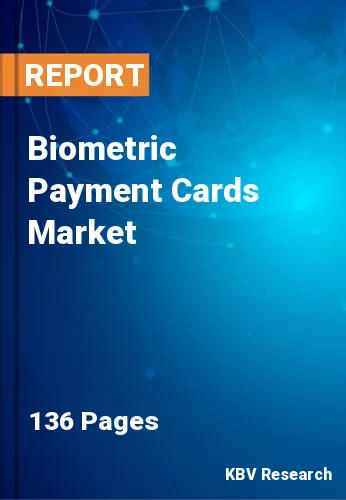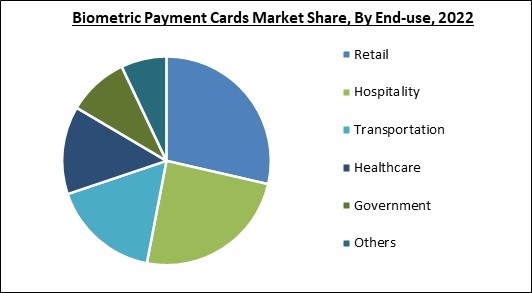
The Global Biometric Payment Cards Market size is expected to reach $2.9 billion by 2028, rising at a market growth of 69% CAGR during the forecast period.
Biometric payment is a point-of-sale (POS) technology that utilizes physical traits to identify the user and allow the withdrawal of money from a bank account. The most widespread biometric payment method is fingerprint payment, which is centered on finger scanning. The system frequently employs two-factor authentication, wherein a finger scan replaces a card swipe and the user writes in a personal identification number (PIN) as usual.

The quantity of contactless card transactions is increasing quickly in various economies throughout the world. For instance, according to a Mastercard, contactless transactions will expand by a significant number in the first quarter of 2020. Contactless payment is used by nearly each and every people, and many individuals are keen to continue to use it after the pandemic, owing to its safety and ease. Around the same time, new regulations were being implemented throughout Europe. Payment service providers must monitor and detect unauthorized or fraudulent transactions under the strong customer authentication (SCA) provision of the European Union's regulation on payment services (PSD2).
These dreams may soon become a definite future, as an increasing number of banks are testing the technology. For example, G+D collaborated with NXP, a semiconductor business, and Linxens, a security, and Identity Company, to test biometric cards at Crédit Agricole, a French bank. Biometric authentication was deemed to be easier than a PIN by a substantial number of participants, and it was also found to be more secure by a huge margin.
Customers boosted the utilization of biometric authentication by the end of it for payments over a specific amount, the limit of a standard contactless card without the use of a PIN. The debut of biometric payment cards appears to be appropriate as consumers begin to acclimate to a post-pandemic environment. For banks and its customers, a mix of contactless technology increased security and privacy, and the ease of a fingerprint might be a win-win situation.
COVID-19 had an ambiguous impact on the population's living standard. This pandemic has prompted businesses to mobilize swiftly and make both short- and long-term changes to the business models in terms of the product offerings' sales and distribution capacities. The supply networks were affected, causing uncertainty about quarantine duration and impacting product sales. The pandemic has hastened the implementation of electronic services throughout all industries. The growing desire to reduce the spread of this virus, which may be spread by touching things, has fueled the demand for contactless biometric solutions. The use of fingerprints and palm-print identification technology has dropped over this time.
Consumer electronics manufacturers, such as those that make smartphones, tablets, notebooks, laptops, and home automation devices, are eager to incorporate innovative features and functions into the products in order to attract new clients and increase the customer base. End-users are becoming more concerned about security as users utilize advanced linked devices and digital technologies to handle sensitive data. As a result, present consumers seek to access bank accounts, email accounts, and other sensitive data such as medical records and financial information via devices that accept biometric authentication.
In latest years, biometric solutions have seen drastic technological development. Advances in sensing technology, as well as the ubiquitous usage of devices like computers and cell phones, have opened up new possibilities for gathering physiological and behavioral characteristics of humans and analyzing associated data for biometric authentication. Biometric systems backed by machine learning as well as artificial intelligence technologies are giving new possibilities for effectively identifying any anomalous behavior and providing an extra layer of authentication if needed. To prevent data breaches, biometric systems with multi-factor authentication are getting traction.

Biometric system vendors cater to specialized applications in banking, financial services, government, and insurance (BFSI), consumer electronics, automotive, and a variety of other industries. The cost of developing, manufacturing, installing, maintaining, and shipping the complicated biometric system is enormous. High-performance biometric systems have a lot of software as well as hardware elements (fingerprint readers, scanners, sensors, electronic locking systems, cameras) that cost a lot of money to install and maintain. More advanced biometric technologies necessitate upgraded raw materials and sub-components, resulting in increased costs.
Based on Card Type, the market is segmented into Credit Cards and Debit Cards. The Debit Cards segment procured a substantial revenue share in the biometric payment cards market in 2021. Companies active in the biometric payment card sector are testing debit cards with fingerprint sensors as part of a pilot program. Moreover, the majority of these market participants have completed debit card pilots. For example, NatWest bank and Visa debit cards began a three-month countrywide experiment with some customers.
Based on End Use, the market is segmented into Retail, Hospitality, Transportation, Healthcare, Government, and Others. The Retail segment acquired the highest revenue share in the biometric payment cards market in 2021. NFC technology, QR codes, and voice payment techniques have all been adopted by the retail business, generating prospects for segment growth. Additionally, merchants are increasingly embracing the digital and contactless payment card methods.
| Report Attribute | Details |
|---|---|
| Market size value in 2021 | USD 122.8 Million |
| Market size forecast in 2028 | USD 2.9 Billion |
| Base Year | 2021 |
| Historical Period | 2018 to 2020 |
| Forecast Period | 2022 to 2028 |
| Revenue Growth Rate | CAGR of 69% from 2022 to 2028 |
| Number of Pages | 136 |
| Number of Tables | 146 |
| Report coverage | Market Trends, Revenue Estimation and Forecast, Segmentation Analysis, Regional and Country Breakdown, Competitive Landscape, Companies Strategic Developments, Company Profiling |
| Segments covered | Card Type, End-use, Region |
| Country scope | US, Canada, Mexico, Germany, UK, France, Russia, Spain, Italy, China, Japan, India, South Korea, Singapore, Malaysia, Brazil, Argentina, UAE, Saudi Arabia, South Africa, Nigeria |
| Growth Drivers |
|
| Restraints |
|
Based on Regions, the market is segmented into North America, Europe, Asia Pacific, and Latin America, Middle East & Africa. North America emerged as the leading region in the biometric payment cards market with the largest revenue share in 2021. The existence of a significant number of enterprises participating in the industry can be linked to the regional market's expansion. As per Visa, a significant number of Visa cards in New York will be able to make contactless payments. The introduction of contactless to all subways & buses by the New York MTA is fostering such acceptance.
Free Valuable Insights: Global Biometric Payment Cards Market size to reach USD 2.9 Billion by 2028

The major strategies followed by the market participants are Partnerships. Based on the Analysis presented in the Cardinal matrix; Visa, Inc. and Mastercard, Inc. are the forerunners in the Biometric Payment Cards Market. Companies such as Zwipe, Infineon Technologies AG, Thales Group S.A. are some of the key innovators in the Market.
The market research report covers the analysis of key stake holders of the market. Key companies profiled in the report include Infineon Technologies AG, NXP Semiconductors N.V., Thales Group S.A., Visa, Inc., Mastercard, Inc., IDEX Biometrics ASA, Zwipe, Bio-idz, and Goldpac Group.
By Card Type
By End Use
By Geography
The biometric payment cards market size is projected to reach USD 2.9 billion by 2028.
Growing usage for identification and authentication of applications in consumer electronics are driving the market in coming years, however, the significant cost involved with the biometric systems limited the growth of the market.
Infineon Technologies AG, NXP Semiconductors N.V., Thales Group S.A., Visa, Inc., Mastercard, Inc., IDEX Biometrics ASA, Zwipe, Bio-idz, and Goldpac Group.
The growing desire to reduce the spread of this virus, which may be spread by touching things, has fueled the demand for contactless biometric solutions.
The Credit Cards segment acquired maximum revenue share in the Global Biometric Payment Cards Market by Card Type in 2021, thereby, achieving a market value of $1.80 billion by 2028.
The Asia Pacific market dominated the Global Biometric Payment Cards Market by Region in 2021, and would continue to be a dominant market till 2028; thereby, achieving a market value of $721.9 Million by 2028.
Our team of dedicated experts can provide you with attractive expansion opportunities for your business.
